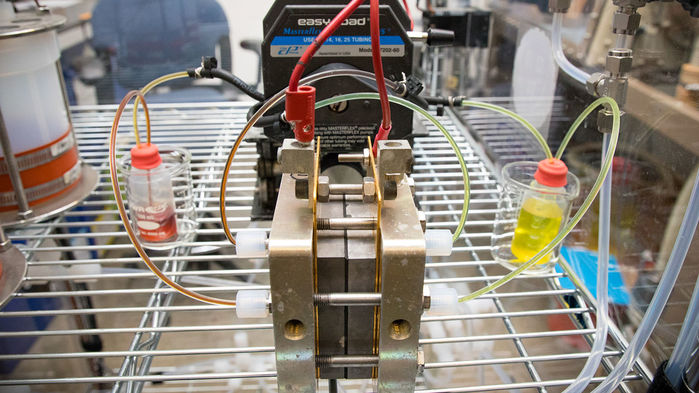
With solar and wind electricity prices plunging, the hunt is on for cheap batteries to store all this power for use around the clock. Now, researchers have made an advance with a flow battery, the type of battery being developed to soak up enough excess wind and solar power to fuel whole cities. They report the discovery of a potentially cheap, organic molecule that can power a flow battery for years instead of days.
Flow batteries have the same components as the typical lithium-ion cells in your cellphone, but work in a way that allows them to be scaled up to provide megawatts. They have pairs of electrodes that convert energy stored in chemicals into electricity, and electrolytes that ferry charges from one electrode to another. But where conventional batteries package electrodes and electrolytes together in a cell, flow batteries keep them separate. Energy is stored in external tanks of charged liquid electrolytes that can be any size—which makes it easier to store large amounts of renewable power. During use, positive and negative electrolytes are pumped through the electrodes, which extract electricity, a process that is reversed during charging.
Today, flow batteries can store and discharge large amounts of electricity more safely, cheaply, and durably than lithium-ion batteries. But they still rely on relatively expensive electrolytes that incorporate vanadium metal particles. Chemists have been looking to organic compounds called quinones as an alternative. Organic-based flow batteries can be a third the cost of those that use vanadium, but they wear out after repeated charging cycles in an industry that expects them to last for a decade or more.
“The lifetime of organic flow batteries is the main reason they are struggling to be commercialized,” says Susan Odom, a chemist at the University of Kentucky in Lexington.
So, Harvard University materials scientist Michael Aziz and his colleagues set out to improve the lifetimes of quinones.
He and his colleagues report the creation of a new quinone called DBEAQ, which they also call the Methuselah molecule after the long lived biblical character. The team added two arms called carboxylic acids to a previously discovered quinone to make it more soluble in alkaline solutions. They could put more DBEAQ into electrolyte solution at a lower, less chemically harsh pH. That and other chemical changes lowered DBEAQ’s capacity degradation loss to just 3% per year, the researchers reported this month in Joule.
Previous quinone-based flow batteries degraded by similar amounts every day. If the Methuselah quinone can be produced at a large scale as cheaply as other quinones—and that’s currently unknown—its performance could already be good enough for commercial viability, Aziz says.
“They did a very good job in designing the quinone molecules,” says Tianbiao Liu, a chemist a Utah State University in Logan, who also works on flow batteries. However, he notes, this flow battery, like others, uses two different electrolytes to operate. And the second electrolyte still has degradation problems that still needs to be solved. “That’s still a challenge for the field to overcome,” he says.
If the field manages to do so, banks of organic flow batteries could energize the world’s switch to renewables, allowing them to provide power not only when the sun and wind are at their peak, but whenever they are needed.
